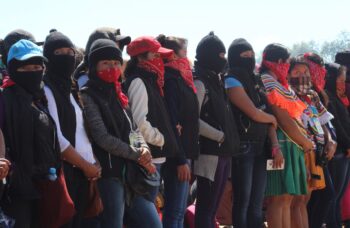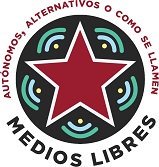
Pueblos Indígenas
(Español) “Proponemos la construcción de la autonomía”, comunidades de Chiapas, peregrinan en San Cristóbal de las Casas
San Cristóbal de las Casas, Chiapas. 25 de enero de 2020. “Como pueblo creyente proponemos la construcción de la autonomía de nuestras comunidades, recuperando nuestras estructuras de usos y costumbres, y la autodeterminación de los pueblos sustentada en el artículo 169 de la OIT”, expresaron este sábado integrantes de la diócesis de San Cristóbal, tras una peregrinación en el marco del noveno aniversario de la pascua del obispo emérito Samuel Ruíz García. Las y los indígenas y mestizos organizados como “Pueblo Creyente”, también se comprometieron a mantener “la resistencia frente a los proyectos de muerte”, así como a “recuperar nuestros gobiernos autónomos, comunitarios y ejidales”. 
Desde una concurrida concentración a un costado de la catedral de San Cristóbal, indicaron que desde sus “opciones diocesanas por los pobres y la madre tierra, queremos expresar los dolores y sufrimientos de nuestros pueblos”. “Nuestros pueblos están sufriendo la situación de injusticia y atropellos a sus derechos fundamentales, como corrupción e impunidad con la confabulación de las autoridades, junto a amenazas y desplazamientos forzados de las comunidades que son divididas por diversos intereses económicos y políticos”, señalaron los pueblos provenientes de diferentes partes de la geografía chiapaneca.
“La falta de empleos y seguridad social; reclutamiento de personas para grupos de la delincuencia organizada y trata de personas, que trae como consecuencia la migración de las comunidades a las ciudades de otros estados de la república, estados unidos y Canadá, provoca la desintegración familiar”, enumeraron las comunidades organizadas. “Estamos en una sociedad consumista que cada vez produce más basura, contaminación y daño a nuestra casa común, la madre tierra”, abundaron.
“El sistema educativo no forma conciencia, responde a los intereses neoliberales y por ello no dan vida al pueblo. El servicio de salud en lo general es insuficiente por la falta de una buena atención médica y la falta de medicamentos y médicos especialistas. Son muchos los centros de salud abandonados en las comunidades, la gente pobre sigue careciendo de atención médica”, puntualizaron los pueblos organizados.
“Nos entristece la inseguridad. Hay asaltos, robo, secuestros, asesinatos, enfrentamientos de diversos grupos del crimen organizado. Hay empresas nacionales e internacionales extractivistas, que provocan contaminación y destrucción de los recursos naturales: como tala de árboles, acaparamiento y privatización del agua, promoción de monocultivos que erosionan la tierra y despojan de su fruto, la modificación de nuestras semillas criollas de parte del Monsanto, trae consecuencias de muerte”, evidenciaron.
“Todo esto sustenta y promueve el sistema económico neoliberal”, enfatizaron en su comunicado las comunidades que peregrinaron. Ejemplo de ello son “las afectaciones que traerá la autopista de Pijijiapan Comitán y San Cristóbal Palenque, a los pueblos y la reserva de la biósfera el Triunfo”, advirtieron.
“Nos solidarizamos con el caminar de los pueblos que buscan la vida y la defienden cuando está en riesgo, así como los que defienden los derechos de las mujeres y la equidad de género; y las familias víctimas de la violencia y sus desaparecidos. Nos solidarizamos con el dolor de los hermanos de Santa Marta, Aldama, Chalchihuitán, Chabenabal y los demás pueblos y comunidades que sufren desalojo, desplazamiento, división y muerte”, añadieron los pueblos indígenas y mestizos ante el panorama local, nacional e internacional que afecta su tierra y territorio. 
Video Frayba:
https://m.facebook.com/story.php?story_fbid=490006328302295&id=368073686557643
Audio reportaje comunicación Abejas de Acteal:
https://archive.org/details/peregrinacion25deenero2020
Pronunciamiento:
COMUNICADO DE LA PEREGRINACIÓN DEL PUEBLO CREYENTE DE LA DIÓCESIS DE SAN CRISTÓBAL
DIÓCESIS DE SAN CRISTÓBAL DE LAS CASAS
COMUNICADO DEL PUEBLO CREYENTE
POR EL NOVENO ANIVERSARIO DE LA PASCUA DE JTATIK SAMUEL,
POR LOS VEINTE AÑOS DEL III SÍNODO DIOCESANO
Y POR EL SEGUNDO AÑO DE MONS RODRIGO CAMINANDO CON NOSOTROS.
25 DE ENERO 2020
A la opinión pública
Al pueblo de Dios en general
A los gobiernos estatal y federal
A los medios de comunicación
A los hombres y mujeres de buena voluntad.
“Y la Palabra se hizo carne, y puso su Morada entre nosotros, y hemos contemplado su gloria, gloria que recibe del Padre como Hijo único, lleno de gracia y de verdad” (Jn 1, 14).
Celebramos la abundante vida que Dios concedió a jTatic Samuel en su fructífero servicio episcopal en nuestra diócesis.
Como Pueblo Creyente reafirmamos nuestra fe en el Dios de la Vida y nuestra identidad como Iglesia, Pueblo de Dios que peregrina en estas tierras, creemos y proclamamos que somos una Iglesia Autóctona, Liberadora, Evangelizadora, Servidora, en Comunión y Bajo la Guía del Espíritu Santo.
Somos Pueblo Creyente porque somos sujetos constructores de nuestra historia, vivimos y luchamos por una vida comunitaria proponiendo una cultura más humana en la sociedad. Estamos conscientes que el Reino de Dios se va construyendo en la búsqueda de la reconciliación, la unidad, la paz y la justicia.
Desde nuestras Opciones Diocesanas por los pobres y la Madre Tierra, queremos expresar los dolores y sufrimientos de nuestros pueblos:
Nuestros pueblos están sufriendo las situaciones de injusticia, atropellos a sus derechos fundamentales, corrupción e impunidad con la confabulación de las autoridades junto con amenazas y desplazamientos forzados de las comunidades que son divididas por diversos intereses económicos y políticos.
Hay falta de empleos, inseguridad social, reclutamiento de personas para grupos de delincuencia organizada y trata de personas, que trae como consecuencia la migración de las comunidades a las ciudades, a otros estados de la República, a Estados Unidos y Canadá, con los que se provoca una desintegración familiar.
Estamos en una sociedad consumista que cada vez produce más basura, contaminación y daño a nuestra Casa Común, la Madre Tierra.
El sistema educativo es deficiente, controlado y manipulado, una educación que no forma conciencia y responsabilidad ciudadana, más bien responde a intereses neoliberales y por ello, no dan vida al pueblo.
El servicio de salud, en lo general, es insuficiente, notable en varios hospitales abandonados, la falta de atención médica, falta de medicamentos y médicos especialistas; son muchos los centros de salud abandonados en las comunidades. La gente pobre sigue careciendo de atención médica.
Nos entristece la inseguridad, hay asaltos, robos, secuestros, asesinatos de personas, enfrentamientos de diversos grupos del crimen organizado.
Hay empresas trasnacionales y nacionales extractivistas que provocan contaminación y destrucción de los recursos naturales como son: tala de árboles, acaparamiento y privatización del agua y humedales; promoción de monocultivos que erosionan la tierra y despojan de su fruto. Las fumigaciones en nuestras tierras y la modificación de nuestras semillas criollas de parte de Monsanto traen consecuencias de muerte. Todo esto promueve y sustenta el sistema económico neoliberal. Las afectaciones que traerá la “autopista de Pijijiapan a Comitán y San Cristóbal Palenque” a los pueblos y a la reserva de la biosfera el Triunfo (Área Nacional Protegida) será de grandes consecuencias para las personas y daño ecológico.
Respetamos a quienes esperan un cambio con el gobierno actual, pero que exijan y trabajen por el cambio que nuestro país necesita. Nos preocupan los viejos grupos de poder que no quieren perder el poder político, pues continúan en el poder económico y mediático, ya que son quienes siguen manteniendo las viejas estructuras de dominación, despojo y división en nuestras comunidades por medio de la manipulación.
Dios Padre-Madre ha sembrado la semilla del profetismo en este Pueblo de nuestra Diócesis de San Cristóbal de Las Casas, que hoy y en toda la trayectoria de nuestro Proceso Diocesano, acompañado por nuestro amado jTatic Samuel Ruiz García, sembró la semilla de ser profeta y forjador de profetas con la palabra tejida en una gran labor pastoral que desembocó en el gran fruto de los acuerdos del III Sínodo Diocesano del cual celebramos los primeros 20 años de Vida Sinodal y Eclesial.
“Para poder anunciar la esperanza de la fe y denunciar la situación social injusta en que viven las comunidades, debemos mantenernos firmes y no tener miedo a evangelizar, aunque haya amenazas, mentiras y críticas destructivas. Recordemos que Jesús nuestro Señor y María nuestra Madre nos ayudan y nos dan fuerza para seguir adelante influyendo con mayor ahínco en la transformación de nuestro México” (III Sínodo Diocesano 66).
Los frutos que han dado vida en el caminar con la Palabra de Dios y del III Sínodo Diocesano son:
El despertar de la conciencia del Pueblo, ha fortalecido nuestra fe y esperanza en el Dios vivo y presente en medio del pueblo, la lucha por una Vida Digna, la autonomía, la fraternidad, la articulación de diversos sectores de la vida social y eclesial, las alternativas de construcción social, el cuidado de las semillas nativas, la soberanía alimentaria, un gobierno para la comunidad, la libertad, la resistencia, mantener viva la palabra de los antepasados que nos dan vida, la vida verdadera y abundante, la fuerza del pueblo organizado, el cuidado de la Casa Común, la búsqueda de la unidad en la diversidad con hermanas y hermanos de otras denominaciones religiosas como práctica ecuménica sin dejar nuestra identidad eclesial.
Miramos como flores y frutos la consolidación y organización de las áreas e instancias pastorales como Pueblo Creyente, Teología India, Pastoral de la Tierra, Derechos Humanos, Migrantes, Coordinación Diocesana de Mujeres, Comunidades Eclesiales de Base, Catequesis de Niños, Catequesis de Adultos, Promotoras y promotores de Salud, Pastoral Penitenciaria, Ministerios Ordenados e instituidos como el Diaconado Permanente entre otros servicios y carismas que el Espíritu Santo va suscitando para el bien del Pueblo de Dios.
Como Pueblo Creyente proponemos:
Construir la autonomía en nuestras comunidades, recuperando nuestras estructuras de usos y costumbres y de la Autodeterminación de los pueblos que se sustentan en el artículo 169 de la Organización Internacional del Trabajo. Mantener nuestra resistencia frente a los proyectos de muerte y recuperar nuestros gobiernos autónomos comunitarios y ejidales, defender a la Madre Tierra y el Territorio con nuestra forma de vida a través de las acciones en conjunto: talleres, ayunos y oraciones.
Nos solidarizamos con el caminar de los pueblos que buscan la vida y la defienden cuando está en riesgo:
Nuestra solidaridad fraterna y sororal es para con los pueblos, los colectivos y organizaciones que buscan la vida y la defienden cuando están en riesgo los derechos de las mujeres y la equidad de género. Nos solidarizamos con las constructoras y constructores de la reconciliación comunitaria, con las familias de los miles de personas desaparecidas víctimas de la violencia, con los jóvenes que se arriesgan por su fe y sus ideales, con el dolor de las hermanas y hermanos de Santa Marta, Aldama, Chalchihuitán, Chavajeval, y los demás pueblos y comunidades que sufren desalojo, desplazamiento, división y muerte.
“La situación actual es difícil y compleja; pero no estamos solos. Contamos con la ternura misericordiosa de Dios Padre, que nos ha dado a su Hijo y su Espíritu. Hemos sido creados a su imagen y semejanza. Dios no abandona la obra de sus manos. Jesucristo nos llama y nos envía. Unidos a Él, daremos fruto en abundancia; separados de Él no podremos hacer nada (cf. Jn 15, 5). ¡Caminemos juntos, a la luz del Señor!“ (Carta Pastoral, Caminemos juntos, a la luz del Señor n. 55).
Pueblo Creyente.
San Cristóbal de las Casas, Chiapas.

(Español) Consejo Supremo Indígena de Michoacán Convoca al III Congreso Estatal Indígena de Michoacán: El Plan P´urhépecha.
Ante los recientes hechos de violencia y represión en las comunidades originarias por parte del Estado mexicano, el Consejo Supremo Indígena de Michoacán (CSIM) convoca al III Congreso Estatal Indígena de Michoacán: El Plan P´urhépecha, denominado así en honor al Plan de Ayala realizado por Emiliano Zapata. El Congreso se realizará en la comunidad de Jucutacato del Municipio de Uruapan, el sábado 25 de enero a las 9 horas en la cancha de la Plaza Principal.
La convocatoria va dirigida a los Jefes de Tenencia, a los Representantes y Comisariados Ejidales y Comunales, a los Jueces Menores y Tradicionales, a los Concejos de Gobierno Comunal, y en general a las comuneras y comuneros de las comunidades indígenas, así como a sus bases de apoyo y simpatizantes.
Las Mesas de Trabajo que llevarán a acabo son: 1.- Represión y Criminalización de las Comunidades Originarias. 2.- Presupuesto Directo, Autodeterminación, Autogobierno y Autonomía. 3.- Territorio, Justicia y Seguridad Comunal. 4.- Educación y Comunalidad. 5.- Mujeres, Vida y Libertad y 6.- Jóvenes y Autonomía.
Finalmente señalaron que por acuerdo de Asamblea General de Autoridades, no se permitirá la entrada a ningún funcionario Municipal, Estatal o Federal, así como de personas no gratas para las comunidades.
A continuación, la convocatoria completa:










